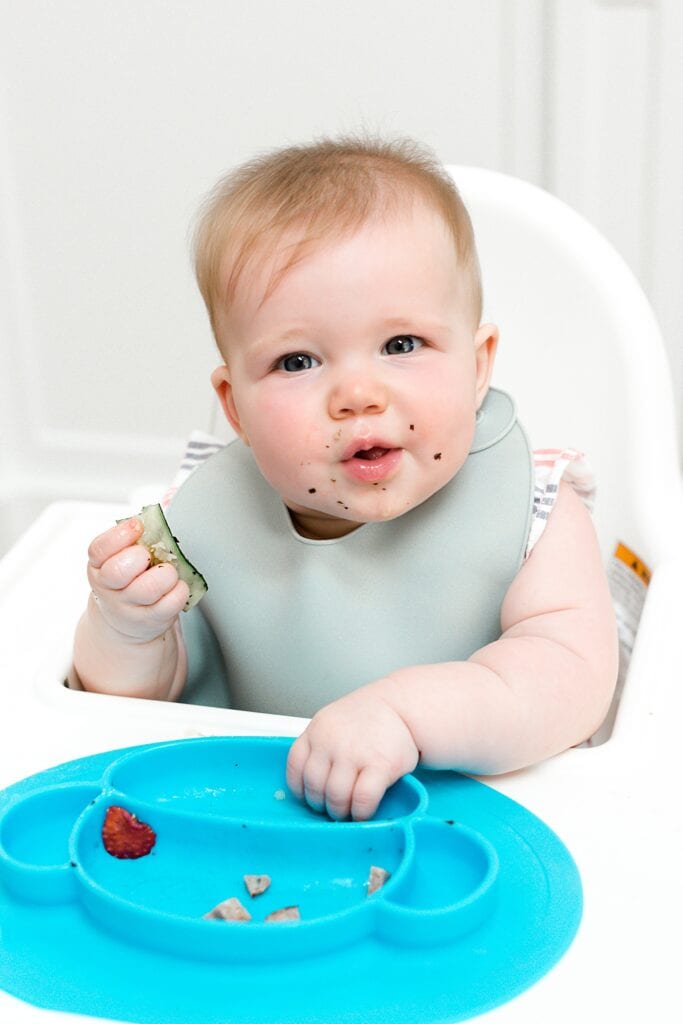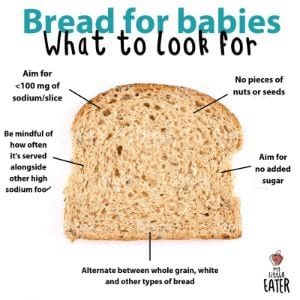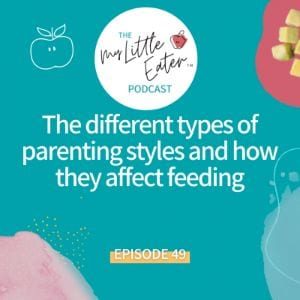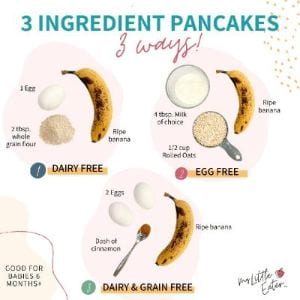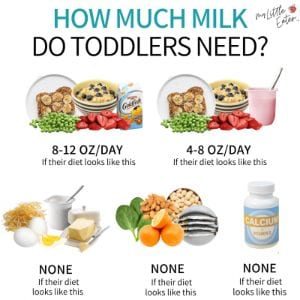Without fail, you will just get your baby on a “schedule” – something flexible but predictable – and then they’ll be ready to start solid foods. So what does that mean for your baby’s (6 to 12 month old) feeding schedule?
Most parents worry about how to fit everything in, and have concerns about balancing milk feedings with solid foods. That’s completely normal!
That’s why I’ve created these sample schedules so you can follow them right from 6 months when your baby starts showing the readiness signs for starting solids and is eating one or two meals only. Then continue to follow them, making adjustments all the way up to 12 months when you’re graduating into toddlerhood and things shift yet again as your child is eating three meals and one or two snacks per day.
Let’s go over how often your baby needs to eat by month, and my tips for fitting it all in, first. And if you have questions about how much your baby should be eating at each of these meals on the schedule, download my free portions guide below to get all the answers you need for that!
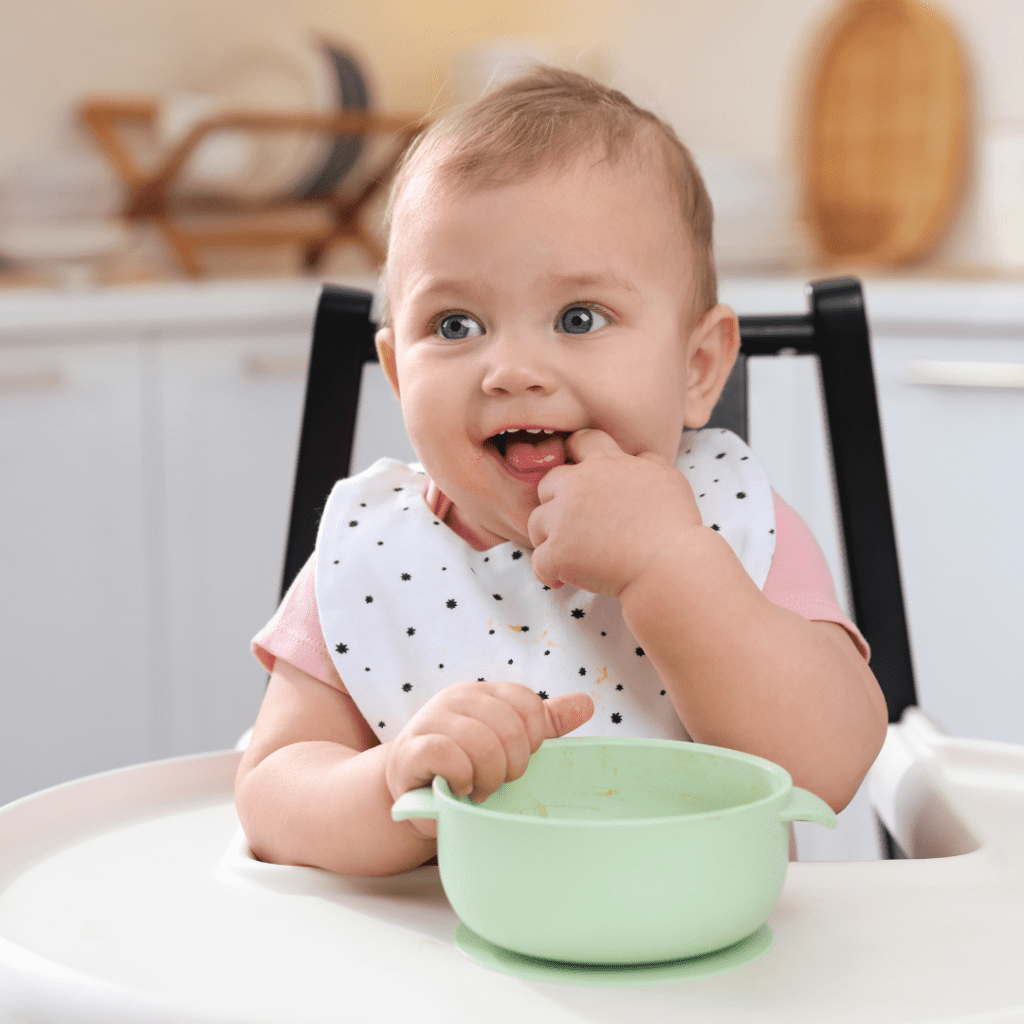
The most common questions I receive about feeding babies are WHEN to feed them…how OFTEN to feed them… and how do solid foods fit in with milk feedings. Seriously… every week on Instagram these questions keep coming up and I totally get it – it’s a big change!
I think it’s so confusing for parents because typically answers to these questions can really vary. Meal schedules are so dependent on your baby’s sleep schedule, how many meals your baby is eating at that time, and also how often they’re nursing or having bottles. Making sure your baby fits everything into a day can feel overwhelming – for such little babies they sure have jam-packed schedules!
PS. If you prefer to listen instead, check out my podcast episode below!
That being said, there are some guidelines you can follow to help create a schedule that works for you and your baby. One that will ensure your baby works up an appetite for solids while still providing enough opportunities to drink breastmilk or formula throughout the day. We have to be mindful of this because, especially right in the beginning of starting solids, your baby’s schedule needs to allow for enough milk feedings as this will continue to be their main source of nutrition. If you want to learn more about how much solid food they should be eating, download my free portion guide for babies below!

HOW TO SET UP BABY FEEDING SCHEDULES
First, I want to say that these are definitely GUIDELINES and not rules you HAVE to adhere to. Your baby’s schedule may be slightly different than the schedules I’m about to show you – that’s ok, and in fact…that’s what I expect!
Second, schedules may change on occasion due to a gazillion circumstances. What’s important is that you try to keep things routine and be fairly consistent with how far apart you space meals and milk feedings, while still allowing for some flexibility when required.

You’re still going to largely use your baby’s hunger and fullness cues to determine if you should move up or push back a solid food meal, or milk feeding, day to day. And we all know that sleep can be affected by a million things, so if their sleep schedule is off one day, it’s going to affect their feeding schedule too.
Be sure to review my blog post on feeding cues for babies so you know what to be watching for and can respond accordingly. All in all, use your judgement and aim for consistency, when possible.
WHY SCHEDULES ARE SO IMPORTANT FOR BABIES
General routines and schedules ARE important with feeding babies because otherwise, you run the risk of overfeeding them or having a hangry baby on your hands. Also, the ability to come to the table with a slight hunger leads to acceptance of solid food meals. No baby is going to take to solids (especially new ones) when they’re too full and uninterested.
However, babies that are too hungry are also going to struggle. When they’re so hungry, it’s difficult for them to concentrate or be patient enough to learn this new task. It takes a lot of effort, strength, and concentration to be able to hold themselves upright, reach for food, explore the food and eventually eat it too. And if they’re too hungry or tired, they won’t be able to do those things successfully.

Another thing to consider that I speak about with toddlers frequently, is that the goal is not to have a FULL baby all the time. Sometimes we push milk or food so frequently that your baby doesn’t have the option of having an empty stomach ever. That feeling of full therefore becomes their new normal, and responding to every cry or emotion with milk or food becomes yours. Again, my post on feeding cues can help you decipher when hunger is truly the issue.
WHEN TO GRADUALLY ADD MORE MEALS AND SNACKS AS BABY GETS OLDER
I’m going to show you through these schedules what the natural progression is with adding in more meals and snacks as well. Again, your baby may add meals or snacks a little earlier, or for some, a little later, but generally, you do want to follow these guidelines within a month before or after what’s recommended here. This is how you continually advance your baby, and keep them progressing!

The more exposure they have to solid food as the months go on, the more they’ll gain the skills they need to be competent and healthy eaters by one year of age. It will be natural for your baby to require less and less milk as the months go on in year 1 – this is not a bad thing. But, we still want them drinking a minimum amount of milk to ensure hydration and maximum nutritional benefits, which is why I’ve included that in the tables below as well.
It’s always possible to decrease the number of meals or snacks being offered if you find they aren’t drinking the minimum amount of milk required for their age. But, skipping over offering solids, finger foods, and a variety of textures by 9 months of age so they get the practice, skills, and nutrition they need, can’t be reversed!
If you’re struggling with knowing what to offer, how to offer finger foods and what the “rules” around nutrition for your baby are, my Baby Led Feeding online course is what you need! This online course will help your baby progress from purées to finger food swiftly and advance in the self-feeding skills they need over months 6-12, all while maximizing nutrition and raising an adventurous eater.
Let’s go through some sample guideline schedules, please feel free to adjust timings based on your baby’s, or family’s, schedule. My recommendation is to sub in your baby’s wake time and adjust each time slot accordingly.

Note: times listed are suggested START times and not an indication of duration of a meal/event. And while we’re on that topic – we don’t want these meals/snacks to last forever and ever. Keep things moving along swiftly, or it will last so long that it interferes with the next feeding. I recommend to aim for 30 minutes (and be prepared for your baby to be over it or full in 5 to 10 minutes sometimes), but certainly no more than 45 minutes as the absolute max length for a mealtime.
6-7 MONTHS OLD FEEDING SCHEDULE
#Meals: 1-2
#Milk feedings: 6-8
Total amount of milk: At least 24 oz.
Milk Feedings: About every 2.5 - 3.5 hours based on hunger cues
Solids: About 30 min - 1.5 hours after previous milk feeding
6:30am
7:30 AM
9:30 AM
10:00 AM
12:00 PM
2:30 PM
3:00 PM
5:00 PM
6:00 PM
7:30 PM
8:00 PM
Wake & Milk Feeding
Breakfast
Milk Feeding
Nap
Milk Feeding
Milk Feeding
Nap
Milk Feeding
Supper
Milk Feeding & Bedtime Routine
Bedtime
8-9 MONTHS OLD FEEDING SCHEDULE
#Meals: 2-3
#Milk feedings: 4-6
Total amount of milk: At least 24 oz.
Milk Feedings: About every 2.5 - 3.5 hours based on hunger cues
Solids: About 30 min - 1.5 hours after previous milk feeding
By 9 months, the goal is to have them at 3 meals per day. Milk may naturally begin to decrease as you consistently provide this.
6:30am
7:30 AM
9:30 AM
10:00 AM
12:00 PM
12:30 PM
2:30 PM
3:00 PM
5:00 PM
6:00 PM
7:30 PM
8:00 PM
Wake & Milk Feeding
Breakfast
Milk Feeding
Nap
Milk Feeding
Lunch
Milk Feeding
Nap
Milk Feeding
Supper
Milk Feeding & Bedtime Routine
Bedtime
10-11 MONTHS OLD FEEDING SCHEDULE
#Meals: 3
#Snacks: 1
#Milk feedings: 3-5
Total amount of milk: 16-24 oz.
Milk Feedings: About every 2.5 - 3.5 hours based on hunger cues
Solids: About 30 min - 1.5 hours after previous milk feeding or spaced about 2 ½ – 3 hours apart from last solid food meal/snack
You can begin to add one snack per day here if you like. Milk may naturally begin to decrease as you consistently provide 3 meals a day, especially if they’re eating more calories via solids. This is ok - we’re prepping for toddlerhood!
6:30am
7:00 AM
9:30 AM
10:00 AM
12:00 PM
12:30 PM
2:30 PM
3:00 PM
5:00 PM
6:00 PM
7:30 PM
8:00 PM
Wake & Milk Feeding
Breakfast
Optional Snack or Milk Feeding
Nap
Optional Milk Feeding
Lunch
Milk Feeding
Nap
Optional Milk Feeding
Supper
Milk Feeding & Bedtime Routine
Bedtime
11-12 MONTHS OLD FEEDING SCHEDULE
#Meals: 3
#Snacks: 1-2
#Milk feedings: 2-4
Total amount of milk: 16-24 oz.
Solids: About 45 min - 1.5 hours after* milk feedings or spaced about 2 ½ – 3 hours apart from last solid food meal/snack
You can begin to make the transition to offering milk (breastmilk, formula, cow milk or alternative) from an open cup around this time with 1-2 meals or snacks per day. This means that milk feedings at separate times may begin to be dropped and instead milk can be incorporated into one sit down meal/snack.
6:30am
7:30 AM
10:00 AM
10:30 AM
12:30 PM
3:00 PM
3:30 PM
5:30 PM
7:30 PM
8:00 PM
Wake & Milk Feeding
Breakfast
Snack + Optional Milk Feeding
(or milk in an open cup)
Nap
Lunch
Snack + Optional Milk Feeding
(or milk in an open cup)
Nap
Supper
Milk Feeding & Bedtime Routine
Bedtime
A note on nursing or bottle feeding schedules and solid foods

If you reach a point where your baby still doesn’t have an appetite for three meals a day, or is forgoing solids for milk, you can experiment with either offering solids before milk (instead of after). Or, you can decide if you want to place limits on the number of nursing sessions, such as sticking to just early morning and late evening, for example.
As your baby approaches one year of age, there needs to be a shift from breast milk and formula providing the majority of your baby’s nutrition to solid foods being their main source of nutrients. This is a gradual shift that happens while approaching 12 months old. It requires your baby to get enough practice with solid food so that they can reliably fill up on solids and not rely on milk intake to feel satisfied and full. If they aren’t getting that practice because they are too full on milk to have enough hunger to eat foods, then it may be necessary to try offering solids before offering a nursing or bottle feeding session.
The switch to cow's milk and its role in picky eating after 12 months

To read more about how to transition from breast milk or formula to cow’s milk (or a milk alternative) read my blog on milk and milk alternatives. That will give you all of the nutritional information you need to make an informed decision about which milk (if any!) comes next for your soon-to-be toddler.
If you’re choosing to continue breastfeeding past one year old – that’s wonderful! Learn all about how to balance breast milk and solid food schedules in toddlerhood, here. And if you’re preparing to move from nursing or bottle feeding to offering whole milk or an alternative in an open cup (or straw cup but skip the sippy cups!), read more about that, here.
Additionally, it’s important to note that once your baby is a toddler – 12 months plus – there is no longer a minimum requirement for milk as there is under 12 months of age. In fact, there’s a maximum! Keep their intake to less than 16oz. per day, which means as you approach that first birthday, you need to be thinking about how much milk they’re consuming, and what your plan is to decrease that, if necessary.
Too much cow’s milk in toddlerhood can cause issues with iron absorption, and can also exacerbate picky eating behavior. If your toddler is too full on cow’s milk or alternative they will have little to no interest in eating table foods, or in trying out any new foods. Keep this in mind and be prepared to continue offering solids according to a feeding schedule in toddlerhood.
Now that you have everything you need to implement a flexible schedule, or routine, with your little one, it’s time to download my FREE portion guide so you know exactly what to expect from your baby, as far as quantity consumed, at each of these meals or snacks.
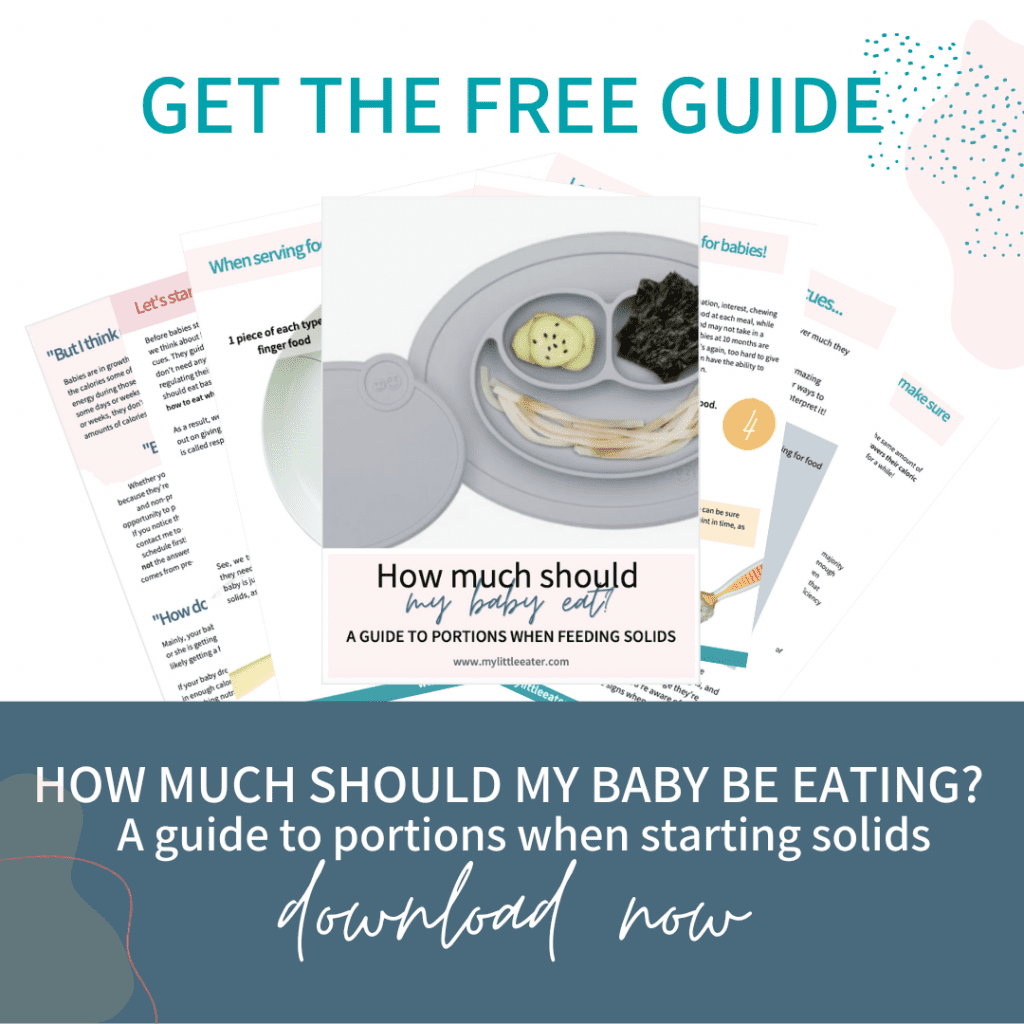
Found this helpful? Pin it to save for later!






